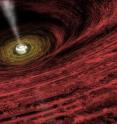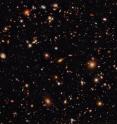X-ray telescope finds new voracious black holes in early universe
Related images
(click to enlarge)
Using the deepest X-ray image ever taken, a University of Michigan astronomer and her colleagues have found the first direct evidence that massive black holes were common in the early universe. This discovery from NASA's Chandra X-ray Observatory shows that very young black holes grew more aggressively than previously thought, in tandem with the growth of their host galaxies. By pointing Chandra at a patch of sky for over six weeks, astronomers obtained what is known as the Chandra Deep Field South (CDFS). When combined with very deep optical and infrared images from NASA's Hubble Space Telescope, the new Chandra data allowed astronomers to search for black holes in 200 distant galaxies, from when the universe was between about 800 million and 950 million years old.
"We had reason to expect that black holes existed in many of the very first galaxies, but they had evaded our searches until now. When I compared Chandra's data to my theoretical models I was stunned by their agreement. It's the dream of any theoretician," said Marta Volonteri, a U-M associate professor of astronomy and co-author of the study that appears in this week's Nature.
The super-sized growth means that the black holes in the CDFS are related to quasars, very luminous, rare objects powered by material falling onto supermassive black holes. However, the sources in the CDFS are about a hundred times fainter, and the black holes are about a thousand times less massive than the ones in quasars.
It was found that between 30 percent and 100 percent of the distant galaxies contain growing supermassive black holes. Extrapolating these results from the small observed field to the full sky, there are at least 30 million supermassive black holes in the early Universe. This is a factor of 10,000 larger than the estimated number of quasars in the early Universe.
"It appears we've found a whole new population of baby black holes," said co-author Kevin Schawinski of Yale University. "We think these babies will grow by a factor of about a hundred or a thousand, eventually becoming like the giant black holes we see today almost 13 billion years later."
A population of baby black holes in the early universe had been predicted, but not yet observed. Detailed calculations show that the total amount of black hole growth observed by this team is about a hundred times higher than recent estimates.
"Until now, we had no idea what the black holes in these early galaxies were doing---or if they even existed," said Ezequiel Treister of the University of Hawaii, lead author of the study. "Now we know they are there and they are growing like gangbusters."
Because these baby black holes are nearly all enshrouded in thick clouds of gas and dust, optical telescopes frequently cannot detect them. However, the high energies of X-ray light can penetrate these veils, allowing the black holes inside to be studied.
Two critical issues in black hole physics are how the first supermassive black holes were formed and how they grow. Although evidence for parallel growth of black holes and galaxies has been established at closer distances, the new Chandra results show that this connection starts earlier than previously thought, perhaps right from the origin of both.
"Most astronomers think in the present-day universe, black holes and galaxies are somehow symbiotic in how they grow," said Priya Natarajan, a co-author from Yale University. "We have shown that this codependent relationship has existed from very early times."
It has been suggested that early black holes would play an important role in clearing away the cosmic "fog" of neutral (uncharged) hydrogen that pervaded the early universe when temperatures cooled down after the Big Bang. However, the Chandra study shows that blankets of dust and gas stop ultraviolet radiation generated by the black holes from traveling outwards to perform this "reionization." Therefore, stars and not growing black holes are likely to have cleared this fog at cosmic dawn.
Chandra is capable of detecting extremely faint objects at vast distances, but these black holes are so obscured that relatively few photons can escape and hence they could not be individually detected. Instead, the team used a technique that relied on Chandra's ability to very accurately determine the direction from which the X-rays came to add up all the X-ray counts near the positions of distant galaxies and find a statistically significant signal.
Source: University of Michigan
Articles on the same topic
- Gamma-ray flash came from star being eaten by massive black holeThu, 16 Jun 2011, 18:36:26 UTC
- Black hole kills star and blasts 3.8 billion light year beam at EarthThu, 16 Jun 2011, 18:36:05 UTC
- Astronomers discover earliest black holes at dawn of universeWed, 15 Jun 2011, 17:36:44 UTC
- Rutgers contributes to findings that black holes were surprisingly common in early universeWed, 15 Jun 2011, 17:36:35 UTC
- Nearby galaxy boasts 2 monster black holes, both activeFri, 10 Jun 2011, 22:32:26 UTC
Other sources
- Black holes dating to the early universe uncoveredfrom LA Times - ScienceSat, 18 Jun 2011, 5:00:21 UTC
- Ultra-Bright Burst of Light Marks the Death Throes of a Star Being Eaten Alivefrom PopSciFri, 17 Jun 2011, 20:30:55 UTC
- Galaxy's Heart Beats in X-Raysfrom Space.comFri, 17 Jun 2011, 16:31:57 UTC
- Rare Sight: Giant Black Hole Devours Star, Fires Beams at Earthfrom Live ScienceFri, 17 Jun 2011, 14:30:30 UTC
- The Hole Picture: Growth of Black Holes and Galaxies Linked from an Early Agefrom Scientific AmericanFri, 17 Jun 2011, 14:30:23 UTC
- ScienceShot: Powerful Jet Being Produced by Star-Eating Black Holefrom Science NOWFri, 17 Jun 2011, 13:50:13 UTC
- Black hole eating star did cause huge blast: reportsfrom CBC: Technology & ScienceFri, 17 Jun 2011, 13:01:03 UTC
- Massive black hole devours starfrom BBC News: Science & NatureThu, 16 Jun 2011, 21:00:35 UTC
- Black hole shreds star, sparking gamma ray flashfrom Reuters:ScienceThu, 16 Jun 2011, 20:50:06 UTC
- Gamma-ray flash came from star being eaten by massive black holefrom Science DailyThu, 16 Jun 2011, 20:30:36 UTC
- Black hole kills star and blasts 3.8 billion light year beam at Earthfrom Science DailyThu, 16 Jun 2011, 20:30:34 UTC
- Unusual Celestial Event Was Black Hole Swallowing a Starfrom NY Times ScienceThu, 16 Jun 2011, 20:20:09 UTC
- Black Hole Caught Eating a Star, Gamma-Ray Flash Hintsfrom National GeographicThu, 16 Jun 2011, 20:00:27 UTC
- Giant black hole eats star, fires beams at Earthfrom CBSNews - ScienceThu, 16 Jun 2011, 20:00:20 UTC
- Unusual gamma-ray flash may have come from star being eaten by massive black holefrom PhysorgThu, 16 Jun 2011, 18:30:51 UTC
- Rare Sight: Giant Black Hole Devours Star, Fires Beams at Earthfrom Space.comThu, 16 Jun 2011, 18:30:21 UTC
- AUDIO: The oldest black holes in the universefrom BBC News: Science & NatureThu, 16 Jun 2011, 12:00:44 UTC
- Black hole growth, galaxy formation linkedfrom UPIThu, 16 Jun 2011, 7:00:24 UTC
- Black hole growth, galaxy formation linkedfrom UPIThu, 16 Jun 2011, 1:20:35 UTC
- X-ray telescope finds new voracious black holes in early universefrom Science DailyWed, 15 Jun 2011, 23:30:24 UTC
- Giant Black Holes Found at Dawn of the Universefrom National GeographicWed, 15 Jun 2011, 21:00:21 UTC
- Astronomers discover earliest black holes at dawn of universefrom Science DailyWed, 15 Jun 2011, 19:30:37 UTC
- X-ray analysis technique helps scientists determine that black holes grew voraciously in young galaxiesfrom Science DailyWed, 15 Jun 2011, 18:30:29 UTC
- NASA's Chandra finds massive black holes common in early universefrom Science DailyWed, 15 Jun 2011, 18:30:25 UTC
- Black holes found to exist since dawn of timefrom CBSNews - ScienceWed, 15 Jun 2011, 18:30:20 UTC
- Secrets of Earliest Black Holes Found in Ancient Galaxiesfrom Space.comWed, 15 Jun 2011, 17:30:46 UTC
- Most distant black holes ever found reveal secretsfrom CBC: Technology & ScienceWed, 15 Jun 2011, 17:30:29 UTC
- Bblack holes were surprisingly common in early universe: studyfrom PhysorgWed, 15 Jun 2011, 17:00:37 UTC
- Twin Supermassive Black Holes Found At Nearby Galaxy's Heartfrom PopSciMon, 13 Jun 2011, 22:00:24 UTC
- How Do Black Holes Form?from Space.comMon, 13 Jun 2011, 18:00:24 UTC
- Which Stars Form Black Holes?from Space.comMon, 13 Jun 2011, 18:00:23 UTC
- Nearby galaxy boasts two monster black holes, both activefrom Science DailySat, 11 Jun 2011, 0:30:27 UTC
- Monster Black Hole Twins Found Inside Galaxy's Bellyfrom Space.comFri, 10 Jun 2011, 22:30:18 UTC
- Our Galactic Neighbor Harbors a Second Black Holefrom Space.comFri, 10 Jun 2011, 20:00:32 UTC
- Nearby galaxy boasts two monster black holes, both activefrom PhysorgFri, 10 Jun 2011, 19:00:29 UTC

